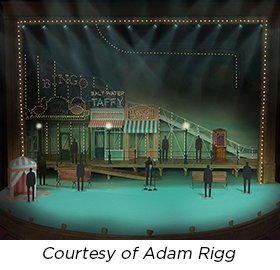The set and costume designer Adam Rigg has worked at many prestigious theaters throughout the United States and Europe. But The Skin of Our Teeth, for which Rigg, who uses they/them pronouns, is the scenic wizard, represents their debut both on Broadway and on LCT’s Vivian Beaumont stage, so I immediately wanted to ask them how they set about conceptualizing the space.
“The Beaumont has long been one of my favorite theaters,” they told me the other day, as the arduous technical rehearsals for Skin were getting underway. “It has been a huge learning curve, partly because the theater’s sightlines are challenging. But also because the space is both epic and intimate, and you want to make use of both qualities.”
The Beaumont’s vast space is conducive to the aesthetic that they and the production’s director, Lileana Blain-Cruz, have developed since meeting as graduates students at the Yale School of Drama. “We share a general aesthetic,” Rigg said. “It’s a kind of maximal minimalism. It’s uncluttered but involves spectacle. We believe in layers and layers of spectacle. Spectacle makes you hyper-aware of the fact that it’s theater you’re watching.”
As Blain-Cruz and Rigg approached The Skin of Our Teeth, the pair incorporated not just the theatricality of plays but the theatricality of cinemas. “We looked at mid-century design,” Rigg explained. “We were fascinated by movie houses of the 1930s and 1940s.” They added: “Wilder’s play has lots of references to escapism, and in those decades, before television and computer screens, the main form of visual escapism was the movies.”
At this point, with the first preview on Friday, I don’t want to give too much away about the look of the production, except to say that it involves various decades of American history. “Lileana’s approach,” Rigg said, “isn’t big on period specificity, and that’s especially appropriate to Wilder’s text, which has virtually no specific dates.”
What can be said right now, because it’s stated in the text, is that the second act takes place in Atlantic City, and that the production tips its hat to one fabled time in that ocean resort’s history. Rigg and the costume designer, Montana Levi Blanco, conjure what Rigg calls “a kind of Sodom and Gomorrah. Gamblers, strippers, showgirls, prostitutes. We’ve had a lot of fun dreaming up that world.”
Rigg’s own background was centered not on the Atlantic but on the Pacific. “I grew up in Los Angeles,” they said, “in the sun, which was lovely.” Their creative ambitions were encouraged from a young age. Rigg was exposed to ballet and theater and concerts. They attended an arts high school and then UCLA, where they majored in theater design and gender studies. Rigg went immediately to grad school at Yale, resulting in that meeting with Blain-Cruz. “I designed her thesis production, which was of Gertrude Stein’s Doctor Faustus Lights the Lights” – a seminal text for American artists classed as avant-garde: Richard Foreman, Robert Wilson, The Wooster Group.
Rigg has designed for modernist and classic plays but their projects after The Skin of Our Teeth involve new work. Most immediately, there are two plays at MCC Theater in New York: Ana Nogueira’s Which Way To The Stage, opening in April, and Donja R. Love’s Soft, opening in May.
“I’ve been very busy,” Rigg said. “Can’t complain about that!”
Brendan Lemon is the editor of lemonwade.com
